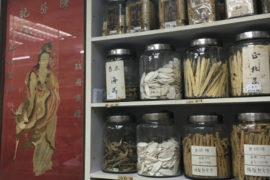
The invisible companionship of tea
(reposted from essay contributed to ‘A Tea Reader : Living Life One Cup at a Time’ Tuttle Publishing )
A decade ago, my buddies and I climbed Hua Shan, known as the most treacherous mountain range in China. Expert rock climbers challenge themselves on this mountain, and the week before we embarked, apparently, 10 climbers died in one week. It is little wonder then that throughout history, only Taoist hermits lived up there in those shrouded peaks, invisible and seeming to float in and out of the visages. But you’d never see many temples or structures. The hermits lived in caves, carved out of the bare, vertical faces of the boulders. At 1600 meters or so, Hua Shan was not really impossibly tall. Instead, it was the scary verticalness that many were challenged by. The bare rock surfaces were carved with slivers of shallow footholds, and we would ascend with the help of metal chains.
The first day of climbing and hiking was a straight 11 hours, a test of endurance, nerves, and the resistance to look down. By the second day, we were in some pretty far reaches and no birds or even ants were seen anywhere. Pine trees jut out of the crevices of the rocks. A sea of clouds were under foot. Many cave dwellings of the hermits were visible but impossible to get to. On the second day, we came upon the most intriguing cave of all: an inset on a sheer boulder the size of a closet, just tall enough for someone to sit cross legged, and also just wide enough. Straw bedding formed a comfortable cushion for the meditator. A thatched screen of some kind served to shield the cave opening from the elements. No one was home, so I sat down on the straw mat, and noticed that the cave interior was just deep enough to hold one person. Looking out into the sea of white clouds, a sheer vertical drop of 5000 feet below churned my stomach. Momentarily, I noticed something to my side, and it was a small stove powered by some sticks of charcoal. On top of the stove, a teapot. I sniffed briefly, and the tea inside must have been of a fermented tea like a Pu-Erh.
I sat waiting in the cave for some time, but the hermit did not return. Was this his entire home? Possibly. We had passed by many caves belonging to other Taoist hermits. They practice immortality by living on the dew drops on the morning plants, and flower petals meshed into wine. They can scale Hua Shan with the lightning speed of monkeys, and indeed, watching some of them fly up and down the mountain, you can barely see their straw shoes touch the rocky steps. They practice circulating their chi, and various esoteric breathing and internal exercises completely unknown to the modern city dweller. But the one I did not meet apparently practiced drinking tea as part of his meditation. Did he subsist on tea alone? Or was tea his one and final worldly attachment? Did he travel to share his tea with another hermit that day we chanced upon his cave, or was tea his only friend? Seeing his teapot and imagining who this hermit was made an indelible connection for me.
Hua Shan was a mystical place. No tea bushes can grow on it, the rocks too bare and hardly any soil could latch itself on them. But the spirit of tea was abundant, the idea of transformation, of possibilities, of cultivation and exploration of self. The invisible experience of tea on Hua Shan. Tea has always been connected with society, of culture and sharing. But the people who dared to live on Hua Shan, took with them the one worldly attachment: tea. An old Chinese proverb came to mind: One can live without food for weeks, but not without tea for even one day! For some of us, tea was our constant companion, if not sometimes, the only companion.
If one can point to a seminal point where the idea of Teance was created, this experience was certainly one such defining moment. Tea is unlike other beverages. It connects invisibly through time and space, to the past and to others who find solace in tea. The companionship that is in that cup extends beyond. With my tea, I am connected to the Taoists who live alone thousands of feet inside a cave on a cliff wondering when they will find their next batch of tea, and when I am drinking tea at Hua Shan, I am connected to my friends in Berkeley, struggling with their last bit of High Mountain Oolong, wondering when I will bring back another batch. Thus, Teance was created to connect the world of tea lovers everywhere, by importing tea directly from these remote mountain regions where they grow. The city person can then share that universe of tea together in spirit with their Taoist counterpart from thousands of miles away, or with tea drinkers from thousands of years ago. Tea transcends time and space.







Comments are closed.